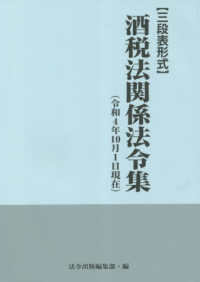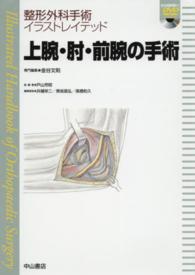- ホーム
- > 洋書
- > 英文書
- > Science / Mathematics
Full Description
Transcranial stimulation encompasses noninvasive methods that transmit physical fields-such as magnetic, electric, ultrasound, and light-to the brain to modulate its function. The most widespread approach, transcranial magnetic stimulation (TMS), has emerged as an important tool in several areas of neuroscience as well as in clinical applications in psychiatry and neurology. Originally envisioned as a way to measure the responsiveness and conduction speed of neurons and synapses in the brain and spinal cord, TMS has also become an important tool for changing the activity of brain neurons and the functions they subserve as well as an causal adjunct to brain imaging and mapping techniques. Along with transcranial electrical stimulation techniques, TMS has diffused far beyond the borders of clinical neurophysiology and into cognitive, perceptual, behavioural, and therapeutic investigation and attracted a highly diverse group of users and would-be users. Another major success of TMS has been as a treatment in psychiatry, where it is now in routine use worldwide. The field of noninvasive neuromodulation has matured and diversified considerably in the past decade, with an expansion in the number of tools available and our understanding of their mechanisms of action.
This second edition of The Oxford Handbook of Transcranial Stimulation brings together the latest developments and important advances in all areas of Transcranial stimulation. The new volume captures the rapid progress made since the first edition, and provides an authoritative and comprehensive review of the state of the art. It also highlights challenges, opportunities, and future directions for this rapidly changing field. The book focuses on the scientific and technical background required to understand transcranial stimulation techniques and a wide-ranging survey of their burgeoning applications in neurophysiology, neuroscience, and therapy. Each of its six sections deals with a major area and is edited by an international authority therein. It will serve researchers, clinicians, students, and others as the definitive text in this area for years to come.
Contents
Section I: Physics, Biophysics, and TechnologyAngel V. Peterchev:
1: Boshuo Wang, Aman S. Aberra, Warren M. Grill, and Angel V. Peterchev: Physics and biophysics fundamentals of transcranial stimulation
2: Dennis Q. Truong, Niranjan Khadka, Angel V. Peterchev, and Marom Bikson: Transcranial electrical stimulation devices
3: Angel V. Peterchev and Mark E. Riehl: Transcranial magnetic stimulators
4: Risto J. Ilmoniemi, Zhi-De Deng, Luis Gomez, Lari M. Koponen, Jaakko O. Nieminen, Angel V. Peterchev, and Charles M. Epstein: Transcranial magnetic stimulation coils
5: Martin Sommer, Ricci Hannah, Angel V. Peterchev, and Walter Paulus: TMS pulse waveform and direction
6: Axel Thielscher, Kristoffer H. Madsen, Gary E. Strangman, and Bradley E. Treeby: Computational methods for dosimetry
7: Stefan M. Goetz and Thomas Kammer: Neuronavigation
8: Guglielmo Foffani and Antonio Oliviero: Transcranial static magnetic field stimulation
9: Kim Butts Pauly, Zhihai Qiu, and Wynn Legon: Transcranial ultrasound modulation
10: Xinlong Wang, Francisco Gonzalez-Lima, and Hanli Liu: Transcranial infrared laser stimulation
Section II: TMS measures of motor cortical and corticospinal excitability: Physiology, function and plasticityUlf Ziemann:
11: Sein H. Schmidt and Stephan A. Brandt: Motor threshold, motor evoked potential, central motor conduction time
12: Markus Kofler and Vasilios Kimiskidis: Cortical silent period
13: Robin Cash and Ulf Ziemann: Paired-pulse measures [SICI, SICF, ICF, LICI, LCD]
14: Ritsuko Hanajima, Vincenzo di Lazzaro, Yoshikazu Ugawa: Paired-coil measures
15: Ulf Ziemann: Pharmacology of TMS measures
16: Robert Chen and Kai-Hsiang Stanley Chen: Clinical Utility of TMS-EMG measures
17: Risto Ilmoniemi, Nigel Rogasch, and Silvia Casarotto: TMS measures explored by EEG recordings
18: John Rothwell and Ricci Hannah: TMS measures and voluntary motor function
19: Joseph Cla?en, Christoph Zrenner, and Ying-Zu Huang: Changes in TMS measures induced by repetitive TMS
20: Michael Nitsche, Walter Paulus, and Gregor Thut: Changes in TMS measures induced by transcranial direct and alternating current stimulation
Section III: Combining transcranial brain stimulation with brain mappingHartwig R. Siebner:
21: Anke N. Karabanov and Hartwig R. Siebner: Brain mapping and brain stimulation - a framework
22: Raffaele Dubbioso and Axel Thielscher: Transcranial brain stimulation and structural MRI
23: Christian Windischberger, Martin Tik, Axel Thielscher, and Hartwig R. Siebner: Transcranial brain stimulation and functional MRI
24: Charlotte J. Stagg: Transcranial brain stimulation and magnetic resonance spectroscopy
25: Sang Soo Cho and Antonio Strafella: Transcranial brain stimulation and PET
26: Til Ole Bergmann, Leo Tomasevic, and Hartwig R. Siebner: Transcranial brain stimulation and EEG/MEG
Section IV: Transcranial Magnetic Stimulation in Perception and CognitionVincent Walsh:
27: David Pitcher: Higher level vision
28: Amanda Ellison: Attention and spatial cognition
29: Gábor Csifcsák, Matthias Mittner, and Birte U. Forstmann: Decision Making
30: Marinella Cappelletti and Maria Silvia Saccani: Numerical Cognition
31: Juha Silvanto: State-dependent studies on perception and cognition
Section V: Noninvasive brain stimulation in learning and memoryEric Wasserman:
32: Michael V. Freedberg and Eric Wassermann: rTMS and implicit learning
33: Anke Ninija Karabanov, Elinor Tzvi-Minker: Effects of electrical brain stimulation on motor learning
34: Melissa Habscher and Joel L. Voss: Transcranial stimulation of episodic memory networks
35: Bradley R. Postle, Eva Feredoes, and Jeffrey S. Johnson: Working memory
36: Ainslie Johnstone, James J. Bonaiuto, and Sven Bestmann: Computational Neurostimulation
37: Anita S. Jwa: Ethical Issues in Transcranial Stimulation for Enhancement
Section VI: Therapeutic Applications of Transcranial StimulationSarah Lisanby:
38: Colleen Loo, Donel Martin, and Adriano Moffa: New developments in the treatment of depression with tDCS
39: Leanne Williams: Stratified precision medicine for transcranial magnetic stimulation treatment of Major Depressive Disorder
40: Noah S. Philip, Nick Petrosino, McKenna Brennan: TMS in the treatment of posttraumatic stress disorder
41: Bruce Luber and Lysianne Beynel: Cognitive enhancement using Noninvasive Brain Stimulation (NIBS), with application to normal and pathological cognitive decline in aging
42: Bernadette Fitzgibbon and Siobhan Schabrun: Transcranial Stimulation and the Pain Experience
43: Flavio Frohlich and Fred Jarskog: Non-Invasive Brain Stimulation in Schizophrenia
44: Lindsay Oberman, Peter Enticott, and Melissa Kirkovski: Experimental and Therapeutic use of Transcranial Stimulation techniques in Autism Spectrum Disorder
45: Zhi-De Deng and Sarah H. Lisanby: Next Generation Seizure Therapy







